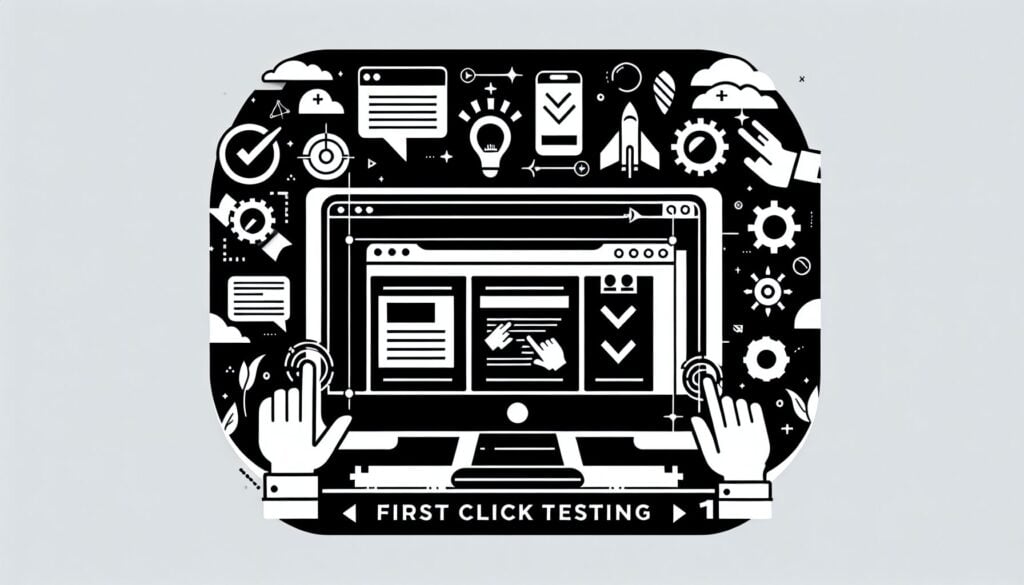Un método de pruebas de usabilidad que evalúa la eficacia de la navegación y el rendimiento de un sitio web. arquitectura de la información rastreando dónde haría clic primero un usuario para completar una tarea específica.
- Metodologías: Clientes y marketing, Ideación, Diseño de producto
Pruebas de primer clic

Pruebas de primer clic
- Pensamiento de diseño, Arquitectura de la información, Diseño de interacción, Usabilidad, Pruebas de usabilidad, Experiencia de usuario (UX), Interfaz de usuario (UI), Pruebas de usuario, Diseño centrado en el usuario
Objetivo:
Cómo se utiliza:
- A los participantes se les asigna una tarea y se les muestra una imagen de una página web (o prototipo). Se les pide que hagan clic donde irían primero para intentar completar la tarea. Se registran los porcentajes de éxito y la ubicación de los clics.
Ventajas
- Es rápido y barato de realizar; puede hacerse con wireframes o maquetas, incluso antes del desarrollo; proporciona información clara sobre si los usuarios pueden encontrar lo que buscan.
Contras
- Sólo comprueba el primer paso de una tarea, no todo el flujo; no proporciona información cualitativa sobre por qué los usuarios hacen clic donde lo hacen (a menos que se combine con otros métodos); el diseño de la tarea es fundamental.
Categorías:
- Diseño de producto
Ideal para:
- Evaluar la eficacia de la navegación y el etiquetado de enlaces viendo dónde hacen clic primero los usuarios para completar una tarea.
La prueba del primer clic desempeña una función vital en la evaluación de la experiencia del usuario, especialmente durante las primeras fases del diseño del producto, como el desarrollo del concepto y el diseño de la interfaz de usuario. Esta metodología se utiliza con frecuencia en sectores como el comercio electrónico, el desarrollo de software y la creación de aplicaciones móviles, en los que una navegación web eficaz es fundamental para la satisfacción y el compromiso del cliente. Durante los estudios de usabilidad, a los participantes sólo se les muestra una imagen estática de una página web o prototipo en lugar de un sitio totalmente funcional, lo que permite realizar pruebas rápidas antes de comenzar el desarrollo. Esto proporciona a los equipos de producto información en tiempo real sobre cómo interpretan los usuarios el etiquetado de los enlaces y las estructuras de navegación. Los equipos suelen contar con la participación de jefes de producto, diseñadores de UX e investigadores para analizar los datos de clics de forma eficaz, información que puede servir para realizar ajustes en la interfaz antes de llevar a cabo pruebas más exhaustivas. Al identificar las zonas de clics habituales y saber si los usuarios se dirigen al contenido correcto, las empresas pueden mejorar sus diseños de forma iterativa, minimizando los costosos retoques tras el lanzamiento. Como el procedimiento es barato y accesible para pruebas a pequeña escala, pueden evaluarse rápidamente varias iteraciones del diseño, garantizando que el producto final se ajuste a las expectativas del usuario. Los datos empíricos recopilados permiten a los equipos abogar por cambios en el diseño basados en el comportamiento del usuario y no en suposiciones, lo que convierte al método de pruebas en un elemento fundamental de las estrategias de diseño basadas en datos.
Pasos clave de esta metodología
- Defina una tarea específica para los usuarios relacionada con la página web o el prototipo.
- Presente a los usuarios una imagen de la página web o del prototipo.
- Pida a los usuarios que hagan clic en la zona que crean que es el primer paso para completar la tarea.
- Registre la ubicación del clic y si el usuario identifica correctamente a dónde ir.
- Analice los datos de clics para evaluar la eficacia de la navegación y el etiquetado de los enlaces.
Consejos profesionales
- Incorpore la segmentación demográfica en la selección de participantes para descubrir los distintos comportamientos y expectativas de los usuarios.
- Realice rondas iterativas de pruebas para perfeccionar progresivamente el diseño basándose en los resultados anteriores y abordar los problemas que vayan surgiendo.
- Combine los datos de los clics con información cualitativa mediante preguntas de seguimiento para comprender los motivos de las elecciones de los participantes.
Leer y comparar varias metodologías, recomendamos el
> Amplio repositorio de metodologías <
junto con otras más de 400 metodologías.
Sus comentarios sobre esta metodología o información adicional son bienvenidos en la dirección sección de comentarios ↓ , así como cualquier idea o enlace relacionado con la ingeniería.
Contexto histórico
1986
(si se desconoce la fecha o no es relevante, por ejemplo "mecánica de fluidos", se ofrece una estimación redondeada de su notable aparición)

Publicaciones relacionadas
Programa Maestro de Producción (MPS)
Personalización masiva
Embudo de marketing
Auditoría de marketing
Índice MAPO (Movimiento y Asistencia de Pacientes Hospitalizados)
Planificación de recursos de fabricación (MRP II)